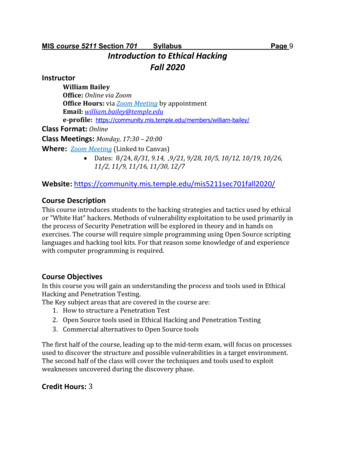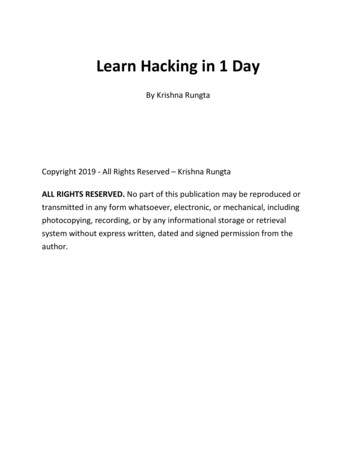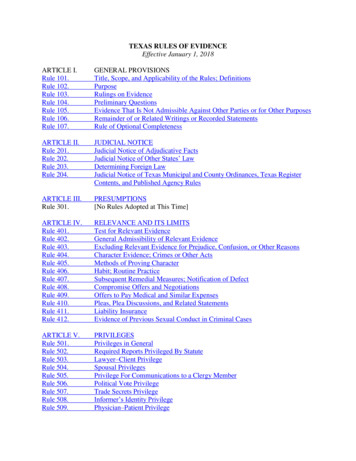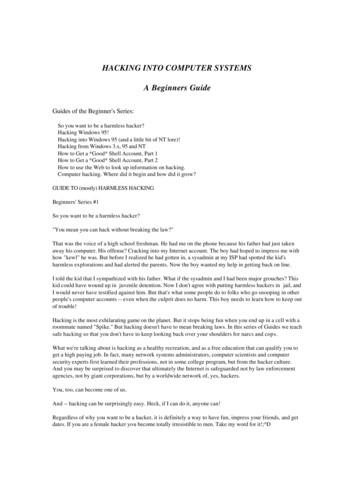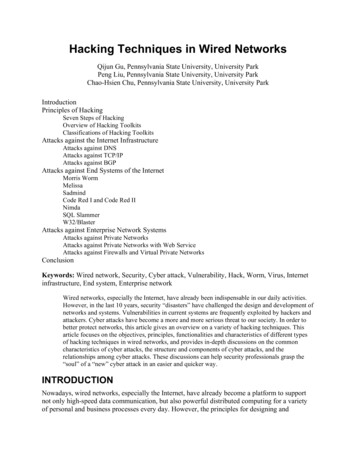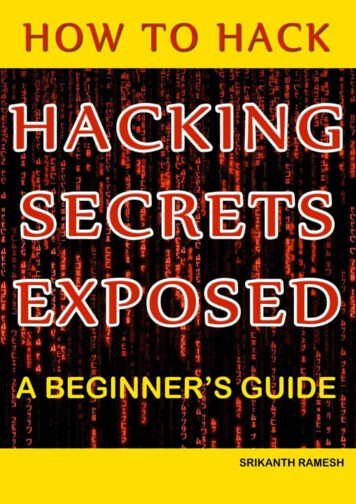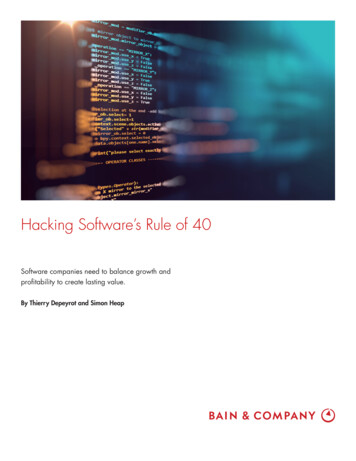
Transcription
Hacking Software’s Rule of 40Software companies need to balance growth andprofitability to create lasting value.By Thierry Depeyrot and Simon Heap
Thierry Depeyrot and Simon Heap are partners with Bain & Company’sGlobal Technology practice, and both work in the firm’s SiliconValley office.Copyright 2018 Bain & Company, Inc. All rights reserved.
Hacking Software’s Rule of 40At a GlanceLarge software companies are, increasingly, measured against the Rule of 40: the idea thatgrowth rate plus profit margin should exceed 40%.Young companies often beat that mark with their rapid growth. But older companies, whosegrowth has tapered off, need to improve performance and profit margins to hit that metric.Beating the Rule of 40 in a single year is admirable, but the greater challenge is balancinggrowth and performance year after year.The Rule of 40—the principle that a software company’s combined growth rate and profit margin shouldexceed 40%—has gained momentum as a high-level gauge of performance for software businessesin recent years, especially in the realms of venture capital and growth equity. Increasingly, softwareindustry executives are embracing the Rule of 40 as an important metric to help measure the trade-offsof balancing growth and profitability.Venture capitalists began to popularize the Rule of 40 in 2015 as a high-level health check for SaaScompanies, but it’s broadly applicable to most software companies. The metric neatly captures the fundamental trade-off between investing in growth (including new products and customer acquisition) andshort-term profitability. Analysts have differed on which measure of profitability to use—most use EBITDA,but some have proposed free cash flow, EBIT or net income as alternatives. We use EBITDA, a publiclyavailable profitability metric that excludes the effect of taxes and accounting policies.Venture capital investors initially came up with the Rule of 40 as a way to quickly assess the performance of small, fast-growing companies. For larger companies, beating the Rule of 40 in a single yearis not exceptional. In fact, over such a short period, the top quintile of software businesses approaches agross profit ratio of 50% (see Figure 1).Consistently strong performance against the Rule of 40, however, is difficult to maintain. Bain & Companyresearched the performance of 124 publicly traded software companies to identify those that outperformed the Rule of 40 over three years and five years. We found that 40% of them outperformedthe Rule of 40 in a single year (2017). But of 86 companies researched from 2013 to 2017, just 25%outperformed the Rule of 40 for three or more years, and only 16% outperformed for all five years,adjusted for mergers and acquisitions (see Figure 2).What’s more, once a business has matured and its growth has slowed, it’s difficult to regain that growth.Among companies with growth rates higher than 10% in 2004–05, average revenue growth sankbelow 10% over time and has not bounced back (see Figure 3). Continuing growth at scale is also hard;only five software companies have grown to 5 billion from 1 billion in the past 20 years.1
Hacking Software’s Rule of 40Figure 1: In 2017, 40% of software companies outperformed the Rule of 40EBITDA margin, 201760%40Revenue growth rate profit margin 40%200–20–40–60–100102040305060%Revenue growth, 2016-17Note: Revenue growth excludes mergers and acquisitionsSources: International Data Corp.; S&P Capital IQ; annual reports; lit search; analyst reports (n 124)Figure 2: Consistently outperforming the Rule of 40 is difficultOut of 53 companies that outperformed the Rule of 40, 22 did so for three or more years33Years ofoutperformancecompanies didn’t outperformthe Rule of 40 for a year053companies did171412Note: Includes companies with data for 2013-17 (n 86)27153–45
Hacking Software’s Rule of 40Figure 3: Revenue growth falls off over time—and is difficult to reviveAverage revenue growth of software companies with 10% growth in 200540%30201002005060708091011121314151617Notes: Includes only companies that were publicly traded in 2017 and had 2004-05 revenue growth of more than 10%; revenue growth excludes mergers and acquisitionsSources: S&P Capital IQ; Bain analysis (n 41)Software companies that can balance growth and profitability to outperform the Rule of 40 have valuations (measured by the ratio of enterprise value to revenue) double that of companies that fall “belowthe line,” and they achieve returns as much as 15% higher than the S&P 500. Companies whose growthslows and that fail to improve profitability often find themselves the target of activist investors andprivate equity acquirers.Three ways to beat the Rule of 40Companies can beat the Rule of 40 at all stages of their life cycle. Strong growth. Of the companies that outperform the Rule of 40 over five years, one-third achieve itwith revenue growth above 30%. These companies—such as Splunk, Wix and Workday—are modestlyprofitable while investing in hypergrowth to build a large installed base, displace legacy vendors andattain the holy grail of becoming a platform. Beyond 1 billion in revenue, software businesses mustevolve their operating model and process maturity to handle the complexities of serving multiple customer segments, with multiple products, across many countries. As growth slows, mature softwarecompanies look for ways to generate more revenue from existing customers, while becoming moreefficient to increase profit margins and maintain performance that beats the Rule of 40. Balanced, profitable growth. Half of the companies consistently exceeding the Rule of 40 do sowith revenue growth between 10% and 30%. Such large, established companies as VMWare, Adobeand Salesforce have successfully developed new products for markets adjacent to their core, andnavigated technology or business model transitions (for example, to SaaS and subscription models)3
Hacking Software’s Rule of 40to keep growing. Having climbed the S-curve, they must reorient their approach to reach thenext level. Some companies accustomed to rapid growth struggle to adapt. For example, R&Dspending needs to reflect the fact that subsequent waves of innovation might not be as valuableas the earlier breakthroughs, relative to the business size, and that the mix of investment mayneed to shift to renewing the original architecture. Disciplined and data-driven portfolio management and investment choices become increasingly important. Profitability. We also found that 18% of companies beat the Rule of 40 with annual organic revenuegrowth below 10%. Established players like Oracle, SAP and Trend Micro have large, profitableflagship businesses. With growth stabilizing below 10%, companies turn to becoming more efficientand profitable—exacting pricing power, leveraging the scale and scope of large salesforces, crossselling and expanding installed base customers, exploring new business models, increasing renewals,moderating R&D investment.Increasing efficiency and effectiveness in a maturing businessIt’s difficult to consistently and sustainably outperform. Each company faces its own unique profitabilitychallenges across products and offerings, engineering efficiency and effectiveness, go-to-market productivityand customer life cycle management. But most successful companies display a few common patterns. Focus on installed base. Customers are the biggest asset of a mature software business. Retaining thatbase, and expanding the value delivered to it, becomes the top priority. Ensuring customer success,investing in customer-centric innovation, developing broader and deeper solutions strategies, andimplementing pricing strategies and discipline are all essential. Customer data can help provide insightson the best ways to deliver, as marketing investments shift to “farming” over “hunting.” They need toestablish more efficient ways of selling to established customers, for example, by deploying inside salesrather than expensive field forces, and paying channel partners based on the value they add. Engineering productivity. Engineering groups face new challenges as a business matures. In additionto being directed by smart portfolio investment choices, engineering groups need to balance thedemands of delivering new features with those of product maintenance—all while dealing withthe technical debt that often slows them down. Getting clarity on priorities and visibility into howsprawling engineering groups are spending time to align with those priorities is paramount. Streamlining roles, supporting critical developers and clarifying site strategy can refocus the best resourceson building what is important in the most cost-effective way. Operational efficiency. For mature companies, the enemy of efficiency is often complexity. Processesand systems reflect historical choices as new products, customer and countries are added to thebusiness mix, along with new acquisitions. Continuous streamlining and process automation canhelp raise efficiency. This can include reducing the number of SKUs and price meters, streamliningthe number of legal entities and channel types, clarifying the roles of operational teams andremoving duplication, and eliminating layers of management.Some of the most successful software businesses gauge their performance against the Rule of 40, andmany others increasingly aspire to achieve it across the various stages of their life cycles. What’s more,the rule is helpful not only at the companywide level, but as a way to assess the performance of businessunits or product families within an organization. Indeed, for some companies, focusing on and achievingthe Rule of 40 at the unit level is an ideal way to get started, allowing them to build the goal into theirbusiness planning and performance assessments.4
Shared Ambition, True ResultsBain & Company is the management consulting firm that the world’s business leaders cometo when they want results.Bain advises clients on strategy, operations, technology, organization, private equity and mergers andacquisitions. We develop practical, customized insights that clients act on and transfer skills that makechange stick. Founded in 1973, Bain has 57 offices in 36 countries, and our deep expertise and clientroster cross every industry and economic sector. Our clients have outperformed the stock market 4 to 1.What sets us apartWe believe a consulting firm should be more than an adviser. So we put ourselves in our clients’ shoes,selling outcomes, not projects. We align our incentives with our clients’ by linking our fees to theirresults and collaborate to unlock the full potential of their business. Our Results Delivery processbuilds our clients’ capabilities, and our True North values mean we do the right thing for our clients,people and communities—always.
For more information, visit www.bain.com
3 1 Largesoftwc mpnis,lypsftsud Software companies that can balance growth and profitability to outperform the Rule of 40 have valu-ations (measured by the ratio of enterprise value to revenue) double that of companies that fall "below

